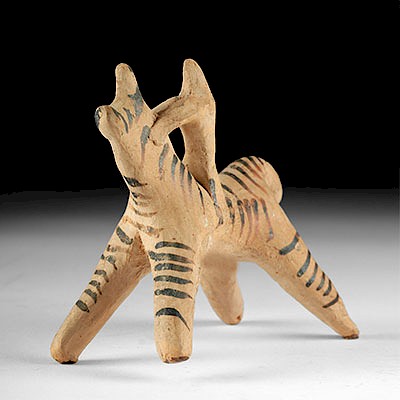9th C. Byzantine Bone Panel - St. George & Horse
Lot 137
About Seller
Artemis Gallery
686 S Taylor Ave, Ste 106
Louisville, CO 80027
United States
Selling antiquities, ancient and ethnographic art online since 1993, Artemis Gallery specializes in Classical Antiquities (Egyptian, Greek, Roman, Near Eastern), Asian, Pre-Columbian, African / Tribal / Oceanographic art. Our extensive inventory includes pottery, stone, metal, wood, glass and textil...Read more
Estimate:
$2,400 - $3,600
Absentee vs Live bid
Two ways to bid:
- Leave a max absentee bid and the platform will bid on your behalf up to your maximum bid during the live auction.
- Bid live during the auction and your bids will be submitted real-time to the auctioneer.
Bid Increments
| Price | Bid Increment |
|---|---|
| $0 | $25 |
| $300 | $50 |
| $1,000 | $100 |
| $2,000 | $250 |
| $5,000 | $500 |
| $10,000 | $1,000 |
| $20,000 | $2,500 |
| $50,000 | $5,000 |
| $100,000 | $10,000 |
| $200,000 | $20,000 |
About Auction
By Artemis Gallery
Oct 25, 2018
Set Reminder
2018-10-25 11:00:00
2018-10-25 11:00:00
America/New_York
Bidsquare
Bidsquare : Antiquities from Egypt, Greece, Italy, Asia
https://www.bidsquare.com/auctions/artemis-gallery/antiquities-from-egypt-greece-italy-asia-3538
Featuring Egyptian, Greek, Roman, Etruscan, Near Eastern, plus Asian art from Central and Far East. If you love the classics, this is the sale for you. Artemis Gallery info@artemisgallery.com
Featuring Egyptian, Greek, Roman, Etruscan, Near Eastern, plus Asian art from Central and Far East. If you love the classics, this is the sale for you. Artemis Gallery info@artemisgallery.com
- Lot Description
Ancient Near East, Holy Land, Byzantine Empire, ca. 9th to 11th century CE. A beautiful panel depicting Saint George, hand-carved from the scapula of a cow or another ungulate. The panel shows the saintly figure holding a lengthy spear while atop his galloping horse, presumably to slay the mythical dragon he is so famous for killing. The horse is shown striding above a slender bar with stippled embellishments. Underneath horse and rider a segmented panel displaying the robed feet and legs of at least two individuals, indicating this panel was likely once part of a larger carved illustration. Custom museum-quality display stand included. Size: 2.125" W x 3.125" H (5.4 cm x 7.9 cm); 4.125" H (10.5 cm) on included custom stand.
Saint George was born in Lydda, Palestine during the 3rd century CE. He became an officer in the Roman army in guard for Emperor Diocletian, demonstrating impressive skill in battle and receiving high honors for his courage. When he learned that Diocletian was preparing to persecute Christians, George presented himself publicly before them emperor and denounced him. The legend of "Saint George and the Dragon," which originated in the 12th century CE, has immortalized the saint. However, this anecdote is rarely presented in iconography. According to tradition, St. George came to Silene in the province of Libya, where a ravaging dragon demanded daily sacrifice. Fate chose the king's daughter, Elisaba, but George subdued the beast. He told the princess to fasten her sash about the dragon's neck so it could be led through the town for conversion of the people before it was killed.
Provenance: private East Coast, USA collection
All items legal to buy/sell under U.S. Statute covering cultural patrimony Code 2600, CHAPTER 14, and are guaranteed to be as described or your money back.
A Certificate of Authenticity will accompany all winning bids.
We ship worldwide and handle all shipping in-house for your convenience.
#135550Piece is a fragment from a larger carving. Motifs are nicely preserved. Item has been repaired from several pieces with some chips, losses, and light adhesive residue along break lines. Some restoration and stabilization material on verso. Surface wear and abrasions commensurate with age, losses to small areas of peripheries, figure, and verso, with fading to some finer details. Light earthen deposits throughout.Condition
- Shipping Info
-
All shipping is handled in-house for your convenience. Your invoice from Artemis Gallery will include shipping calculation instructions. If in doubt, please inquire BEFORE bidding for estimated shipping costs for individual items.
-
- Buyer's Premium



 EUR
EUR CAD
CAD AUD
AUD GBP
GBP MXN
MXN HKD
HKD CNY
CNY MYR
MYR SEK
SEK SGD
SGD CHF
CHF THB
THB














